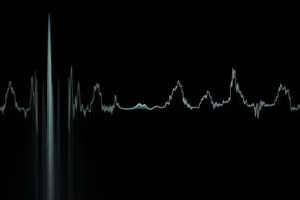Podcast
Questions and Answers
What is a primary advantage of direct radiography over traditional methods?
What is a primary advantage of direct radiography over traditional methods?
- Higher radiation exposure
- Immediate image availability (correct)
- Lower production costs
- Longer processing times
Which technology does indirect radiography use to convert X-rays into light?
Which technology does indirect radiography use to convert X-rays into light?
- Flat-panel detectors
- Amorphous silicon
- Digital sensors
- Scintillator (correct)
How does the workflow of indirect radiography typically compare to direct radiography?
How does the workflow of indirect radiography typically compare to direct radiography?
- Lower image resolution
- Requires additional steps for image conversion (correct)
- More efficient due to fewer steps
- Quicker image processing
What type of detector technology is utilized in direct radiography?
What type of detector technology is utilized in direct radiography?
Which statement accurately compares the image quality of direct and indirect radiography?
Which statement accurately compares the image quality of direct and indirect radiography?
Which of the following is a common material used in scintillator detectors for indirect radiography?
Which of the following is a common material used in scintillator detectors for indirect radiography?
What is a significant downside of film radiography compared to digital systems?
What is a significant downside of film radiography compared to digital systems?
What potentially makes indirect radiography more flexible compared to direct radiography?
What potentially makes indirect radiography more flexible compared to direct radiography?
Flashcards are hidden until you start studying
Study Notes
Principles of Direct Radiography
- Definition: Direct radiography (DR) captures images directly on a digital detector.
- Technology: Uses flat-panel detectors that convert X-rays directly into digital signals.
- Advantages:
- Immediate image availability.
- Reduced radiation exposure compared to traditional methods.
- High image resolution and contrast.
- Workflow: Images can be processed and analyzed quickly, improving efficiency in medical settings.
Principles of Indirect Radiography
- Definition: Indirect radiography (IR) involves a two-step process for image capture.
- Technology: Utilizes a scintillator to convert X-rays into light, which is then detected by a charge-coupled device (CCD) or complementary metal-oxide-semiconductor (CMOS) sensor.
- Advantages:
- Flexible and cost-effective compared to DR.
- Can produce high-quality images with proper setup.
- Workflow: Requires additional steps for image conversion, which may lead to delays.
Comparison of Imaging Techniques
- Direct vs. Indirect:
- DR offers quicker image access and potentially lower radiation doses.
- IR may be less expensive and more widely adopted in certain facilities.
- Digital Radiography vs. Film Radiography:
- Digital systems provide better image manipulation and storage options.
- Film systems may have higher production costs and longer processing times.
- Image Quality:
- DR often yields superior contrast resolution and detail.
- IR can match DR image quality with optimized settings.
Detector Technologies
- Flat-Panel Detectors:
- Used in DR; includes amorphous selenium or amorphous silicon technologies.
- Scintillator Detectors:
- Common in IR; materials like cesium iodide or gadolinium oxysulphide convert X-rays to light.
- Charge-Coupled Devices (CCD):
- Used for capturing light in indirect systems; sensitive and efficient.
- Complementary Metal-Oxide-Semiconductor (CMOS):
- Emerging technology for indirect imaging; offers advantages in speed and energy efficiency.
Applications in Medical Imaging
- Diagnostic Imaging:
- Used for evaluating bone fractures, infections, and tumors.
- Interventional Radiology:
- Assists in guiding procedures such as biopsies and catheter placements.
- Dentistry:
- Vital for detecting cavities and assessing oral health.
- Mammography:
- Essential for early detection of breast cancer, with DR systems increasingly used.
- Pediatric Imaging:
- Lower radiation exposure in DR makes it preferable for children's imaging.
Principles of Direct Radiography
- Direct radiography (DR) captures images directly on digital detectors, streamlining the imaging process.
- Utilizes flat-panel detectors that convert X-rays directly into digital signals, enhancing efficiency.
- Advantages include immediate image availability, reduced radiation exposure, and high image resolution and contrast.
- Quick processing and analysis of images improve workflow in medical environments.
Principles of Indirect Radiography
- Indirect radiography (IR) employs a two-step process for image capture, which involves conversion of X-rays into light.
- Uses a scintillator to convert X-rays to light, detected by CCD or CMOS sensors.
- Known for being flexible and cost-effective, although it may involve additional steps that lead to processing delays.
- Can yield high-quality images when equipment is set up properly.
Comparison of Imaging Techniques
- DR provides faster access to images and typically lower radiation doses than traditional methods.
- IR is often more economically accessible and is more commonly adopted in various medical facilities.
- Digital radiography systems excel in image manipulation and storage compared to film, which has higher production costs and requires longer processing times.
- DR generally offers superior contrast resolution and detail, while optimized IR setups can yield comparable image quality.
Detector Technologies
- Flat-panel detectors in DR utilize technologies like amorphous selenium or amorphous silicon for efficient imaging.
- Scintillator detectors in IR convert X-rays to light using materials like cesium iodide or gadolinium oxysulphide.
- CCDs are sensitive detectors used to capture light in indirect systems, offering efficiency in imaging.
- CMOS technology is emerging for indirect imaging, known for its advantages in speed and energy efficiency.
Applications in Medical Imaging
- DR and IR are crucial for diagnostic imaging, including evaluating bone fractures, infections, and tumors.
- In interventional radiology, these techniques assist in guiding procedures like biopsies and catheter placements.
- Dentistry benefits from radiography for cavity detection and overall oral health assessment.
- Mammography employs DR systems for early breast cancer detection, improving accuracy.
- Pediatric imaging leans toward DR due to lower radiation exposure, making it safer for children.
Studying That Suits You
Use AI to generate personalized quizzes and flashcards to suit your learning preferences.



